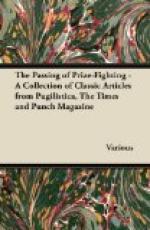“The horse is a noble animal,” as a gentleman once wittily observed, when he found himself, for the first time in his life, in a position to make love; and we beg leave to repeat the remark—“the horse is a noble animal,” whether we consider him in his usefulness or in his beauty; whether caparisoned in the chamfrein and demi-peake of the chivalry of olden times, or scarcely fettered and surmounted by the snaffle and hog-skin of the present; whether he excites our envy when bounding over the sandy deserts of Arabia, or awakens our sympathies when drawing sand from Hampstead and the parts adjacent; whether we see him as romance pictures him, foaming in the lists, or bearing, “through flood and field,” the brave, the beautiful, and the benighted; or, as we know him in reality, the companion of our pleasures, the slave of our necessities, the dislocator of our necks, or one of the performers at our funeral; whether—but we are not drawing a “bill in Chancery.”
With such impressions in favour of the horse, we have ever felt a deep anxiety about those to whom his conduct and comfort are confided.
The breeder—we
envy.
The breaker—we
pity.
The owner—we esteem.
The groom—we respect.
AND
The ostler—we pay.
Do not suppose that we wish to cast a slur upon the latter personage, but it is too much to require that he who keeps a caravansera should look upon every wayfarer as a brother. It is thus with the ostler: his feelings are never allowed to twine
“Around one object, till he feels
his heart
Of its sweet being form a deathless part.”
No—to rub them down, give them a quartern and three pen’orth, and not too much water, are all that he has to connect him with the offspring of Childers, Eclipse, or Pot-8-o’s; ergo, we pay him.
My friend Tom is a fine specimen of the genus. He is about fifteen hands high, rising thirty, herring-bowelled, small head, large ears, close mane, broad chest, and legs a la parentheses ( ). His dress is a long brown-holland jacket, covering the protuberance known in Bavaria by the name of pudo, and in England by that of bustle. His breeches are of cord about an inch in width, and of such capacious dimensions, that a truss of hay, or a quarter of oats, might be stowed away in them with perfect convenience: not that we mean to insinuate they are ever thus employed, for when we have seen them, they have been in a collapsed state, hanging (like the skin of an elephant) in graceful festoons about the mid-person of the wearer. These necessaries are confined at the knee by a transverse row of pearl buttons crossing the genu patella. The pars pendula is about twelve inches wide, and supplies, during conversation or rumination, a resting-place for the thumbs or little fingers. His legs are encased either in white ribbed cotton stockings, or that peculiar kind of gaiter ’yclept




